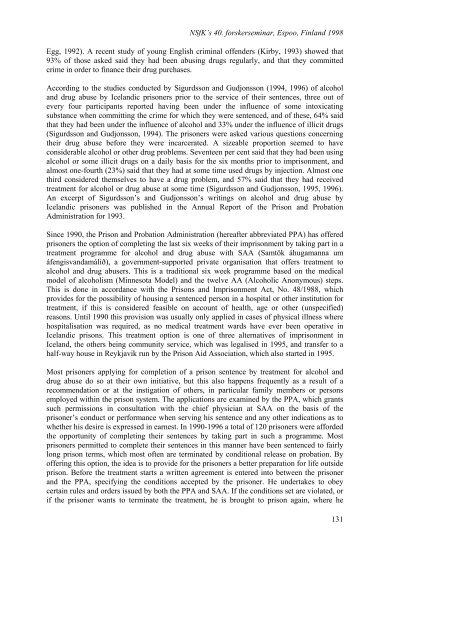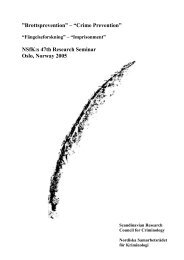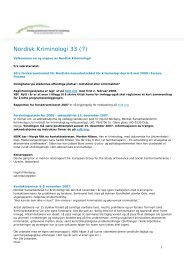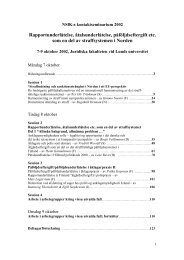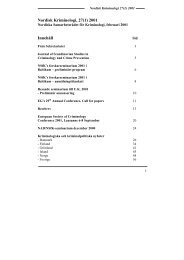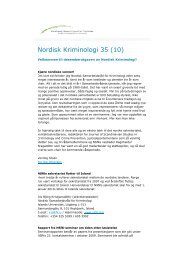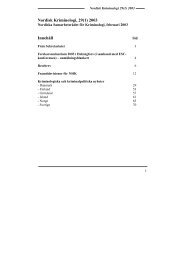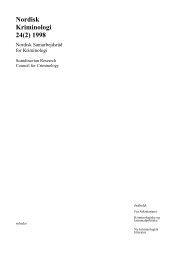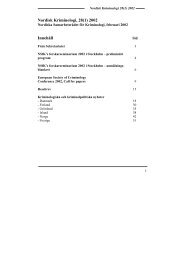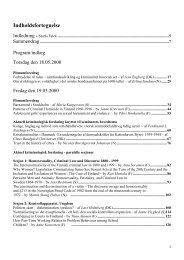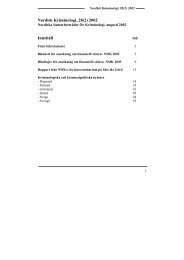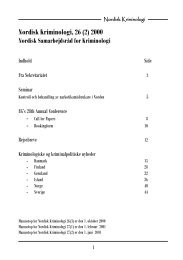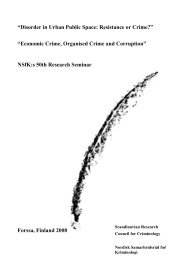Organised Crime & Crime Prevention - what works? - Scandinavian ...
Organised Crime & Crime Prevention - what works? - Scandinavian ...
Organised Crime & Crime Prevention - what works? - Scandinavian ...
Create successful ePaper yourself
Turn your PDF publications into a flip-book with our unique Google optimized e-Paper software.
NSfK’s 40. forskerseminar, Espoo, Finland 1998<br />
Egg, 1992). A recent study of young English criminal offenders (Kirby, 1993) showed that<br />
93% of those asked said they had been abusing drugs regularly, and that they committed<br />
crime in order to finance their drug purchases.<br />
According to the studies conducted by Sigurdsson and Gudjonsson (1994, 1996) of alcohol<br />
and drug abuse by Icelandic prisoners prior to the service of their sentences, three out of<br />
every four participants reported having been under the influence of some intoxicating<br />
substance when committing the crime for which they were sentenced, and of these, 64% said<br />
that they had been under the influence of alcohol and 33% under the influence of illicit drugs<br />
(Sigurdsson and Gudjonsson, 1994). The prisoners were asked various questions concerning<br />
their drug abuse before they were incarcerated. A sizeable proportion seemed to have<br />
considerable alcohol or other drug problems. Seventeen per cent said that they had been using<br />
alcohol or some illicit drugs on a daily basis for the six months prior to imprisonment, and<br />
almost one-fourth (23%) said that they had at some time used drugs by injection. Almost one<br />
third considered themselves to have a drug problem, and 57% said that they had received<br />
treatment for alcohol or drug abuse at some time (Sigurdsson and Gudjonsson, 1995, 1996).<br />
An excerpt of Sigurdsson’s and Gudjonsson’s writings on alcohol and drug abuse by<br />
Icelandic prisoners was published in the Annual Report of the Prison and Probation<br />
Administration for 1993.<br />
Since 1990, the Prison and Probation Administration (hereafter abbreviated PPA) has offered<br />
prisoners the option of completing the last six weeks of their imprisonment by taking part in a<br />
treatment programme for alcohol and drug abuse with SAA (Samtök áhugamanna um<br />
áfengisvandamálið), a government-supported private organisation that offers treatment to<br />
alcohol and drug abusers. This is a traditional six week programme based on the medical<br />
model of alcoholism (Minnesota Model) and the twelve AA (Alcoholic Anonymous) steps.<br />
This is done in accordance with the Prisons and Imprisonment Act, No. 48/1988, which<br />
provides for the possibility of housing a sentenced person in a hospital or other institution for<br />
treatment, if this is considered feasible on account of health, age or other (unspecified)<br />
reasons. Until 1990 this provision was usually only applied in cases of physical illness where<br />
hospitalisation was required, as no medical treatment wards have ever been operative in<br />
Icelandic prisons. This treatment option is one of three alternatives of imprisonment in<br />
Iceland, the others being community service, which was legalised in 1995, and transfer to a<br />
half-way house in Reykjavik run by the Prison Aid Association, which also started in 1995.<br />
Most prisoners applying for completion of a prison sentence by treatment for alcohol and<br />
drug abuse do so at their own initiative, but this also happens frequently as a result of a<br />
recommendation or at the instigation of others, in particular family members or persons<br />
employed within the prison system. The applications are examined by the PPA, which grants<br />
such permissions in consultation with the chief physician at SAA on the basis of the<br />
prisoner’s conduct or performance when serving his sentence and any other indications as to<br />
whether his desire is expressed in earnest. In 1990-1996 a total of 120 prisoners were afforded<br />
the opportunity of completing their sentences by taking part in such a programme. Most<br />
prisoners permitted to complete their sentences in this manner have been sentenced to fairly<br />
long prison terms, which most often are terminated by conditional release on probation. By<br />
offering this option, the idea is to provide for the prisoners a better preparation for life outside<br />
prison. Before the treatment starts a written agreement is entered into between the prisoner<br />
and the PPA, specifying the conditions accepted by the prisoner. He undertakes to obey<br />
certain rules and orders issued by both the PPA and SAA. If the conditions set are violated, or<br />
if the prisoner wants to terminate the treatment, he is brought to prison again, where he<br />
131


